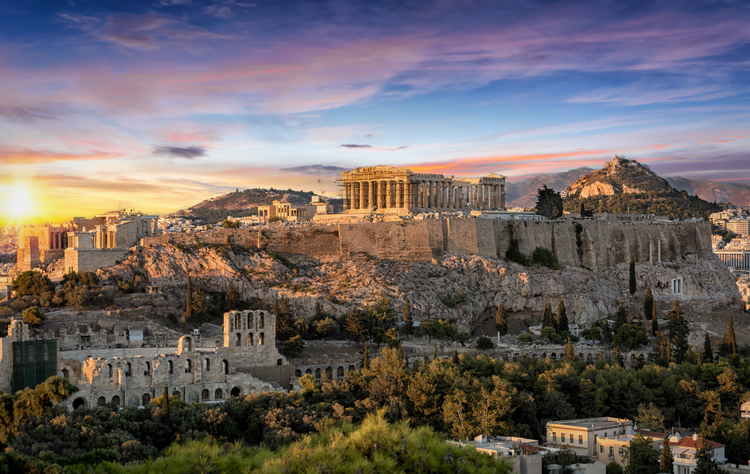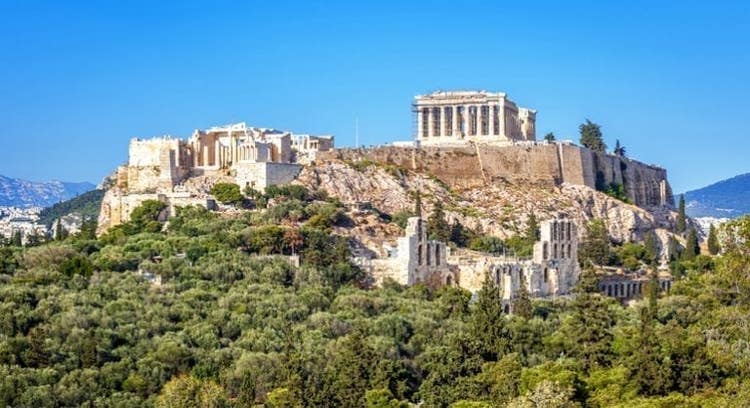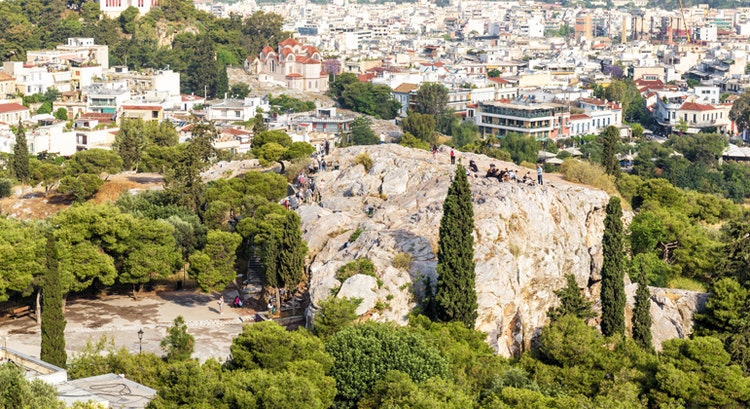
Athens is the Cradle of Western Civilization
Cruises to Athens
Highlights

The Acropolis and Acropolis Museum
If the Acropolis is the most famous of the Athenian landmarks, the Parthenon is far and away from the most iconic. Dedicated to the goddess Athena, the temple was completed in 438 BC after several years of construction. The cultural weight of the Parthenon is unique in the world, and once you’re up there—far above the traffic of the city below—staring up at the massive marble pillars with views of Athens extending all the way to the sea, it feels almost ethereal.
As you make your way up the steep (but relatively short!) path to the top, the first structure you’ll see is the Propylea, which was the monumental gateway to the ancient sacred complex. You’ll also spot the Erechtheion, a structure famous for its six beautiful female Caryatid sculptures. While the structure of the Parthenon is mostly intact, the artifacts that were once there are now mostly on display in the stunning Acropolis Museum, which is located below the Acropolis itself.
Inside it, you can peruse some 4,000-ancient works of art and artifacts starting from the Greek Bronze Age through the archaic and classical periods and beyond, housed in five collections on three levels. In addition to the permanent collections, don’t miss the excellent temporary exhibitions on the ground floor and check out the large restaurant with its astounding Acropolis views, too!

Areopagus and Ancient Agora
The marble path called Dionysiou Areopagitou, named for the first Athenian convert to Christianity following Apostle Paul’s sermon straddles the base of the south slope of the Acropolis and connects several interesting historical sites. These include the Odeon of Herodes Atticus, a spectacular ancient theater that dates to 161 AD and was originally covered with a wooden roof.
Today, open-air cultural performances at the theater are a highlight of the prestigious annual Athens & Epidaurus Festival. Continuing along the path leads you to the beginning of the Areopagus Hill area which is a rocky prominence just northwest of the Acropolis. The site of a criminal court in ancient Athens, today the Areopagus is a magnet for those who come to appreciate the views of the Acropolis from the top of it, which you can easily reach by stairs. A bit farther along you’ll be by the entrance to the ancient Athenian Agora of Athens on one side and the start of the Filopappou Hill, or the Hill of the Muses, on the other. As the beating commercial heart of ancient Athens, the Agora is now home to a veritable catalog of ancient ruins and temples like the bouleuterion (assembly hall) and the Altar of the Twelve Gods, making a detour of any length here a fascinating foray into the past.
This area has a rustic, park-like atmosphere today but if time is lacking, top highlights on your list should be the Museum of the Ancient Agora and superbly preserved Temple of Hephaestus.

The Plaka
And then there’s the Plaka! This enchanting, historic neighborhood curls around the bottom of the south and east slopes of the Acropolis. Cobblestone streets, pastel-colored neoclassical townhouses and myriad shops and cafes make this the most beautiful of all Athenian neighborhoods for a stroll.
After a visit, you could head to nearby Syntagma Square, home of the palatial Greek Parliament building and Monument to the Unknown Soldier. This is where you can see the celebrated Evzones, the elaborately dressed presidential guards who rotate positions every hour. Next to Parliament is where the National Garden begins and on the opposite side of that expanse of green is where you’ll find the Panathenaic Stadium, which the Greeks call Kallimarmaro and is the world’s only stadium made entirely of marble. While its origins are very ancient the Panathenaic Stadium was most famously a prominent venue for the first modern Olympic Games, held in 1896.

Mount Lycabettus
By the way, if you look up and see another peak rising above the crowded center of Athens that isn’t the Acropolis, well that’s Mount Lycabettus and at 909 feet tall it’s actually more than 400 feet taller than the Acropolis! This ancient limestone ridge, covered with pine trees and lush foliage around the base, is said to have been created by the goddess Athena herself and it looms over the posh district of Kolonaki. You walk or can take a funicular to the top, where you’ll find an informal café, a gourmet restaurant and mesmerizing views that stretch all the way to Piraeus and the Mediterranean Sea beyond.